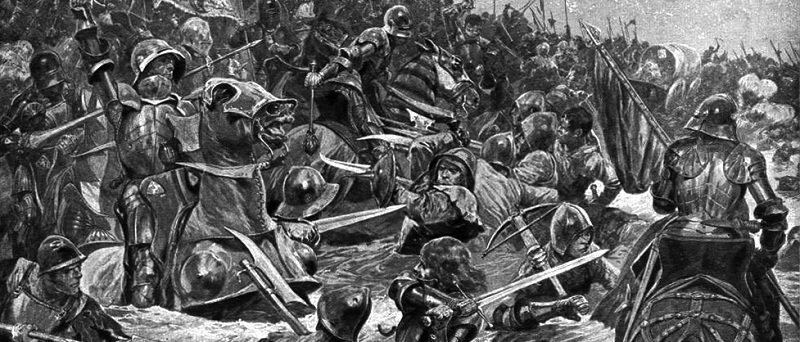Battle of Towton
Posted on 10th January 2021
The Battle of Towton was fought on 29 March 1461. It is described as ‘probably the largest and bloodiest battle ever fought on English soil’.
The Wars of the Roses between the House of Lancaster and the House of York had commenced in 1455 and eight bloody battles had already taken place in the fight for the English throne.
In October 1460 King Henry VI had signed the Act of Settlement, transferring the right of succession to Richard, Duke of York and his heirs, but Henrys wife Margaret of Anjou did not take the disinheriting of her son Edward well, and spent her time raising an army.
Richard, Duke of York had died at the Battle of Wakefield in 1460 and his eighteen-year-old son, Edward, Earl of March was left to lead the Yorkist army.
The Lancastrian army having been victorious at the Second battle of St Albans, marched to London but the city refused to open the gates to them. Unable to enter the city, Margaret marched her forces to York.
London welcomed the Yorkist army. While there the Earl of Warwick named the young Yorkist leader Edward, Earl of March as King Edward IV in March 1461. England now had two Kings, a situation that could not continue.
Edward marched his forces north to confront the Lancastrian army, and a small force met at Ferrybridge with the Yorkist forces defeating the Lancastrians.
Edward would be inspirational to his Yorkist army as he fought beside them, however Henry stayed with his wife Margaret in York and left Edmund Beaufort, Duke of Somerset to lead the Lancastrian army.
The battle took place during a snowstorm on 29 March 1461 on an open field between the villages of Sexton and Towton.
The Yorkist army made the first move with their archers sending a volley of arrows towards Lancastrian forces. With the wind behind them the arrows flew well, plunging into the mass of soldiers. The Lancastrian archers struggled to return fire as their arrows fell short in the face of driving snow.
When Yorkist forces ran out of their own arrows, they plucked Lancastrian arrows from the ground and carried on firing at the enemy.
The Lancastrians stepped forward to fight but were hindered by the thousands of their own arrows sticking out of the ground. They did however fight well and managed to penetrate the Yorkist left wing, leaving Yorkist soldiers fleeing.
Edward, Duke of York stepped forward, took charge and managed to close the breach in the left wing. Seeing this, inspired Yorkist soldiers to stand their ground and fight.
Gradually the Lancastrian army gained the advantage and forced the Yorkists back bit by bit.
Over many hours of hand to hand fighting in thick snow the soldiers became fatigued, however the tide would turn in the Yorkists favour.
John de Mowbray, Duke of Norfolk arrived with reinforcements; these soldiers were fresh for battle and took the upper hand pushing the Lancastrians back. The Lancastrian line started to break and their men started to flee for their lives.
While fleeing, Yorkist archers continued to fire arrows, killing the fleeing men. Others hid in local towns, but were hunted down and killed.
More men died at the Battle of Towton than any other battle, but this did not stop the fight for the English throne and the Houses of York and Lancaster would continue to fight over it for a further twenty-five years.
Battle of Towton
Fought - 29 March 1461
Location - Near Towton, Yorkshire
Participants - House of York and House of Lancaster
Army
York 25,000 - 30,000
Lancaster 30,000 - 35,000
Leaders (York)
Edward, Duke of York (Earl of March)
Richard Neville
William Neville
John de Mowbray, Duke of Norfork
Leaders (Lancaster)
Henry Beaufort, Duke of Somerset
Sir Andrew Trollope
Henry Percy, Earl of Northumberland
Henry Holland, Duke of Exeter
Victory - House of York
Casualties
28,000
Sir Andrew Trollope (Lancaster)
Henry Percy, Earl of Northumberland (Lancaster)
Lord Dacre (Lancaster)
Tagged as: Junior Middle Ages
Share this post:





